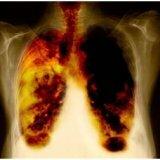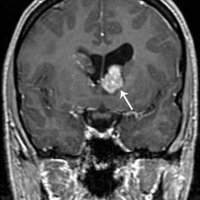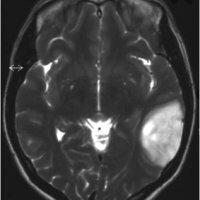Treatment of lung cancer, symptoms

Lung cancer is a malignant neoplasm that develops and forms from the epithelial tissue of the lungs. There are two forms of lung cancer: peripheral cancer( developing on the lung tissue itself) and central cancer( originating from the bronchus).
Malignant tumors of lung cancer are very common. Throughout the world, huge efforts are being made to prevent this dangerous disease, and despite this, the incidence rate continues to grow. So if you compare the number of diseases today with the number at the beginning of the twentieth century, it turns out that the incidence rate has risen several dozen times. In many countries, mortality from lung cancer ranks first in the deaths associated with malignant neoplasms in men. All this leads to a logical conclusion about how important it is to know about the treatment of lung cancer, the symptoms and ways of diagnosing this terrible disease.
Causes of lung cancer.
All malignant neoplasms appear as a result of damage to DNA cells. It can happen because of many factors. The main causes of lung cancer:
- Inhalation of various harmful substances( esters, cokes, resins, etc.).
- Work in hazardous production.
- Smoking.
Very often, lung cancer is detected in people who work in steel shops, wood processing, mines, phosphate and ceramic asbestos cement plants, as well as in the metallurgical industry.
Statistics on the incidence of lung cancer are disappointing: smoking people get sick much more often than non-smokers, about 80% of those suffering from lung cancer are smokers. Scientists have long found the cause of this circumstance. The fact is that in tobacco smoke are contained in large quantities of chemical and physical carcinogens. Also, the development of the disease can affect the presence of chronic inflammatory processes, for example post-tuberculosis scars on the lungs, chronic bronchitis, bronchiectatic disease or chronic pneumonia and many others.
Stages of the disease.
- Zero stage: accumulation of tumor( atypical) cells in the lungs.
- The first stage: a localized tumor up to 3 cm in size, there is no metastasis, lymph nodes are affected.
- Second stage: a tumor larger than 30 mm, or a tumor of smaller dimensions, but with damage to the nearest lymph nodes.
- The third stage: a tumor( large or small) sprouting into the pleura and even into neighboring organs( spine, vessels, esophagus, heart), metastases are extensive, but mostly located in regional lymph nodes.
- Fourth stage: the presence of distant metastases, the tumor itself can be of any size.
Symptoms.
Lung cancer can be difficult to recognize, especially in the early stages of the disease. The fact is that the symptoms of lung cancer can easily be taken for signs of other respiratory diseases, which are many. All this makes the disease extremely difficult to diagnose. In most cases, people do not go to the doctor immediately. And there is no guarantee that the doctor will be able to immediately recognize the disease. The disease has indirect symptoms, which can occur even in the early stages, so it is important to pay attention to this decrease in activity or fatigue, pale skin, apathy and lethargy. There may also be causeless temperature rises( small).
Main symptoms:
- Weight loss.
- Hemoplegia.
- Pain in the thorax.
- Shortness of breath.
- Cough.
Treatment of .
First, in no case should delay treatment of lung cancer. And if you or someone from your relatives was diagnosed with this, you should immediately begin to be treated and follow the recommendations of the oncologist. Immediately discard the idea of self-medication, as this can only worsen the situation.
Unfortunately, in about 15% of cases the disease occurs without any symptoms, so it is important to do an x-ray or fluorography every year. Since if you have lung cancer and you got into these "happy" 15 percent, then you can suspect the disease only from the results of these surveys. Lung cancer in the picture looks like a darkening of the tumor-like nature, if there is one, then you can resort to additional examinations to clarify the diagnosis, it can be:
- Blood test for the level of oncomarkers.
- Puncture biopsy of lymph nodes.
- Transthoracic puncture.
- Bronchoscopy.
- Computed tomography.
If the diagnosis is confirmed, you will have to get acquainted with an oncologist who will develop and prescribe the necessary treatment program, depending on the stage of the disease and what kind of lung cancer it is. There are several ways to treat this radiation therapy, surgery and chemotherapy. In most cases, these methods are assigned in combination with each other.
How hard it will be to fight the disease depends on two factors: the stage in which the disease is located and the histological picture of the tumor.
Lung cancer metastases can spread to bones, the brain, the liver and to another lung, as well as to the lymph nodes and the supraclavicular area.
Unfortunately, compared to other malignant diseases, lung cancer has one of the most disappointing statistics in terms of mortality: in the fourth stage, the chance to survive is almost zero, with the third less than 25%, in the first and second stages in approximately 50% of cases, treatment is effective.
Prevention.
It is important not to trigger various inflammatory diseases and processes in the lungs and bronchi to prevent them from becoming chronic and becoming a potential area for the development of lung cancer. As it may sound banal, but quitting is an extremely important preventive measure. If a person works in hazardous industries under conditions of constant dust, he should use respiratory methods like respirators, masks, etc.



